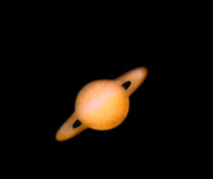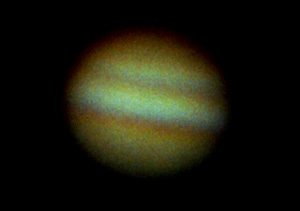Saturn
Taken at 800 magnifications using a tele-extender for eyepiece projection with a 10mm Plossl.
Guided during exposure
"Automatic" setting on camera, about 1 second. Cable shutter release with timer delay to allow vibrations to damp down before exposure.

Jupiter
Taken as above. Two big problems with these magnifications at X 800
1) Focusing. Take a number of shots and refocus each time.
2) Vibrations. Cable release is a must together with a timer delay setting on the camera. Once pressed, do not move until after the shutter closes.
Image greatly enlarged on the iMac.

Jupiter and 4 moons
(Io, Europa, Ganymede & Callisto.)
Taken through the Easy Guider for the wide angle shot.
Taken in colour, reduced to greyscale and enlarged in Photoshop.
Transit of Mercury
May 7 2003
The little black dot is Mercury as it passes in front of the Sun. Taken with wide angle eyepiece at x100 with the digital camera held up to it by hand. Solar filter used.
DANGER!
NEVER VIEW THE SUN WITHOUT A GENUINE SOLAR FILTER OR YOU MAY BE PERMANENTLY BLINDED.
Venus
A difficult subject due to its proximity to the Sun. It is therefore a twilight shot not very high above the horizon. No surface detail ever visible due to its permanent cloud cover. Even in colour appears mostly white. Magnification X 800.
Mars
Taken August 2001 at 800 magnifications. Mars here is at its closest approach for 11 years, but unfortunately for UK observers, appeared only a few degrees above the horizon. There was no prospect for us to glimpse any surface detail at all on this occasion, and to make matters worse, the entire planet was engulfed in a major dust storm. Hence the nondescript orange blob.
magnification X 800